




Located in a historically Black neighborhood that has seen displacement due to urban renewal, The Bottom provides a space for community members to express themselves and celebrate Black excellence.


EDITOR-IN-CHIEF: Abby Ann Ramsey
MANAGING EDITOR: Bella Hughes
COPY CHIEF: Emma Johnston
NEWS EDITOR: Eli Boldt
ARTS & CULTURE EDITOR: Macy Roberts
SPORTS EDITOR: Caleb Jarreau
ASSISTANT SPORTS EDITOR: Jack Church
DIGITAL PRODUCER: Karsten Hoglund
OPINIONS EDITOR: Calie Wrona
PHOTO EDITOR: Cole Moore
DESIGN EDITOR: Emma Fingeret
ENGAGEMENT EDITOR: Sarah Portanka
PAGE DESIGNERS: Jibril Foronas, Katie Goss, Chloe Black
COVER PHOTO: Kinley Sanderson / The Daily Beacon
ADVERTISING MANAGER: Cullen Askew
ADVERTISING REPRESENTATIVES: Jacob
Stromatt
ADVERTISING PRODUCTION ARTISTS: Donatella Thomas, Ailin Lopez
TO REPORT A NEWS ITEM OR SUBMIT A PRESS RELEASE, please email editorinchief@utdailybeacon.com
TO PLACE AN AD, please email admanager@utk.edu.
LETTERS POLICY: Letters to the Editor must be exclusive to The Daily Beacon and cannot have been submitted to or published by other media. Letters should not exceed 400 words and can be edited or shortened for space. Letters can also be edited for grammar and typographical errors, and Letters that contain excessive grammatical errors can be rejected for this reason. Anonymous Letters will not be published. Authors should include their full name, mailing address, city of residence, phone number and e-mail address for verification purposes. Letters submitted without this information will not be published. The preferred method to submit a Letter to the Editor is to email the Editor-in-Chief.
CORRECTIONS POLICY:It is The Daily Beacon’s policy to quickly correct any factual errors and clarify any potentially misleading information. Errors brought to our attention by readers or staff members will be corrected and printed on page two of our publication. To report an error please send as much information as possible about where and when the error occurred to editorinchief@ utdailybeacon.com.
The Daily Beacon is published by students at The University of Tennessee on Wednesday during the fall and spring semesters. The offices are located at 1345 Circle Park Drive, 11 Communications Building, Knoxville, TN 37996-0314. The newspaper is free on campus and is available via mail subscription for $200/year or $100/semester. It is also available online at: www.utdailybeacon. com
On Friday, Feb. 23, members from the Center for Health Education & Wellness and Metro Drug Coalition met in the Student Union to educate and give resources relating to drug storage, usage and mental health.
A major point emphasized at the event was what action to take when encountering an overdose situation. The first step to that is being able to identify the signs when someone is experiencing an overdose. Bethany Lemons, a wellness coordinator at MDC, laid out the signs and symptoms of an opioid overdose.
“A lot of times people get tiny pinprick pupils and have their breathing slow since it’s a depressant,” Lemons said. “They start to shut down and want to pass out.”
Colloquially known as Narcan, naloxone is a nasal spray that rapidly reverses the effects of an overdose with little to no side effects. During the event, wellness coordinators from MDC provided free naloxone and gave demonstrations on how to administer it.
MDC also addressed the common misconception that naloxone can have negative effects when administered to a person who is not actually overdosing.
“There’s a really big misconception that Narcan can hurt if there’s not an opioid overdose, but that’s actually not true. Narcan binds to the opioid receptors in the brain,” Lemons said. “So it doesn’t hurt if it’s something else. It doesn’t help, but it doesn’t hurt either.”
In addition to naloxone, attendees were provided with other free resources, including free fentanyl test strips, safety plans and medication disposal packets designed to dissolve unwanted drugs. Attendees were encouraged to take the free resources to protect themselves and to reduce harm as bystanders. Elle Peeples, a wellness coordinator for CHEW, wanted students to feel empowered by their knowledge should they be in a situation where they need to be active.
“We see the value of this type of event to give students easy and enjoyable access to education and resources on medication safety,” Peeples said. “Ultimately, we aim to empower our students to make smart choices and to have the tools and skills necessary to confidently step up as an active bystander if they see a fellow Vol in need.”
In addition to medication safety, the Knoxville-based nonprofit MDC also specializes in suicide prevention and mental health first aid training.
“We have a recovery community, and recovery is not just substances. It’s mental health as well,” Lemons said. “When you
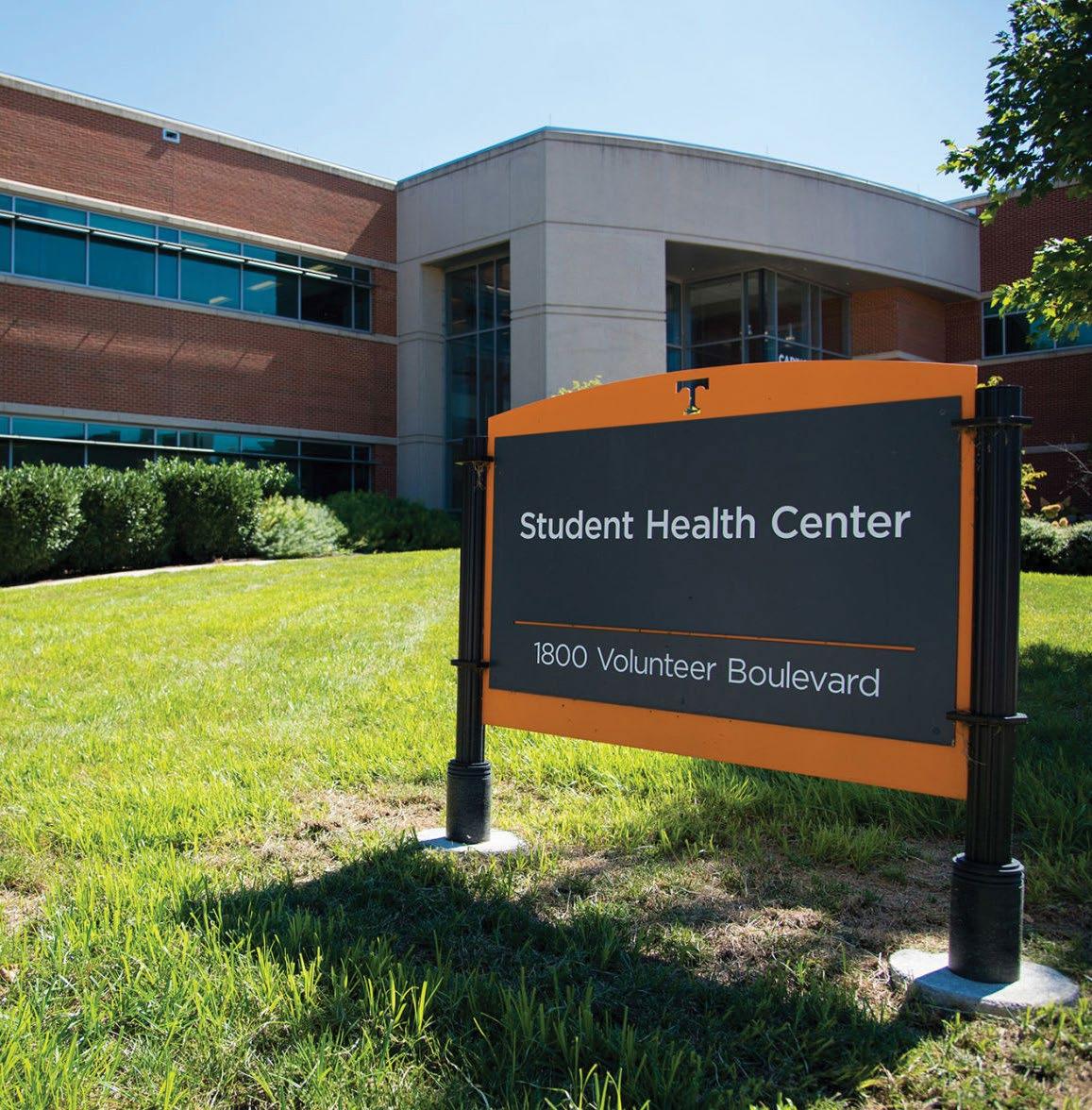
File / The Daily Beacon
come to the gateway, you’re with communities of people who get it in some way or another. I just really want people to know they should reach out to us.”
MDC maintains its commitment to reducing harm in the name of helping people. If students or community members are struggling with drug or mental health issues, MDC’s objective is not to punish or administer consequences. They use an evidence-based approach, supporting a primary goal of harm reduction.
“We have something to offer for everybody, and people shouldn’t be afraid. They should be able to move past the stigma,” Lemons said. “Don’t be afraid to reach out ‘cause we’re not going to get anybody in trouble. We’re here to help. And we aren’t going to look down on you.”
If students or community members are struggling with addiction, they can get help by calling 1-800-662-4357, the national hotline of the Substance Abuse and Mental Health Services Administration. They can reach the national suicide hotline by calling 988.
“When you come to the gateway, you’re with communities of people who get it in some way or another. I just really want people to know they should reach out to us.”
BETHANY LEMONS
Wellness Coordinator at MDC
An award-winning sepsis detection algorithm developed by researchers at UT could have a substantial impact on the identification and diagnosis of sepsis.
Sepsis is a condition typically caused by an infection, like pneumonia or a UTI. When bacteria from said infection spread into the bloodstream, it causes the body to go into “overdrive.” From this overdrive come issues like low blood pressure or a shutdown of vital organs. Sepsis is known for being particularly fast-acting and life-threatening.
“It’s horrific, and it needs to be detected early so that we can intervene with antibiotics and fluids and mitigate the problem,” said Anahita Khojandi, an associate professor in the Department of Industrial and Systems Engineering at UT.
Sepsis is traditionally detected through a series of tests, like a complete blood test, which measures white and red blood cell count, as well as hemoglobin. However, due to the volatile and time-sensitive nature of sepsis cases, blood work like this can raise several issues.
“Biomarkers from blood work, for instance, white blood cell count, is something you only can get with bloodwork. The fact is that it’s intrusive,” Khojandi said. “You need to go take blood from the patient, who is potentially critically ill. And they need all the blood they have.”
What sets the algorithm, called “MLePOMPD,’’ apart from traditional methods of sepsis detection, is that it does not require information gathered through intrusive methods of data collection.
Rather, the algorithm only requires metrics such as blood pressure, heart rate and respiratory rate to determine the presence of sepsis. Another feature of MLePOMPD is the ability to predict sepsis before it even occurs, potentially saving clinicians hours worth of time.
“What we have been trying to do is to look at the history of all of these metrics and more of these biomarkers and see if we can predict when that goal is going to be met, in the hopes that by doing so we can save time,” Khojandi said.
By interpreting easy-to-collect physiological data in relation to factors like mean, maximum, minimum
and time elapsed, MLePOMPD is able to predict sepsis before it is diagnosed with notable accuracy. Zeyu Liu, an assistant engineering professor at West Virginia University, is the main developer of MLePOMPD.
“We’re only using heart rate, respiration rate and three types of blood pressure. So five indicators,” Liu said. “But what we did is use small time windows to ‘expand’ the horizon. So you have a signal. We can take the mean, the maximum and the minimum. … from one signal, we can have three indicators like max, mean and minimum. And we did lots more than that. I think in total we did around 144 indicators extracted from those five signals.”
Beginning work as a graduate student in 2019, Liu’s research on the algorithm would receive two publications in 2022. Along with Khojandi, Xueping Li, Akram Mohammed and Robert L. Davis, Liu won first place in the ICS Harvey J. Greenberg Research Award for innovative studies later that year.
While it will likely be years before clinical trials begin, the ideas behind the algorithm could go well beyond their applications in sepsis. Planning to follow up in the future, Liu noted the possibility for wider medical applications.
“What we’re trying to do is a generic method that can be applied outside sepsis. So basically, coupling another decision-making method on top of machine learning,” Liu said. “We have seen some success in sepsis prediction. But we hope that it can be widely applied to other fields that have some sort of prediction or signal change detection.”
“It’s horrific, and it needs to be detected early so that we can intervene with antibiotics and fluids and mitigate the problem.”
Anahita Khojandi Associate Professor, UT Department of Industrial and Systems Engineering


Knoxville’s The Bottom provides a place for Black community members to express themselves and exchange ideas in order to create greater recognition of Black history and Black excellence.
BELLA HUGHES Managing EditorIn a neighborhood that was once stripped from the Black community resides a group of people who are reclaiming their history and growing their roots once more by establishing a safe space for Black creatives to share their stories in a nontraditional way.
The Bottom, a Black-owned bookstore, coffee shop and space for Black creatives, opened in 2020 during the resurfacing of the Black Lives Matter Movement. The Bottom’s founder and UT alum, Enkeshi ElAmin, is a sociologist who studied race and Black placement and found through a series of interviews that a resounding number of people were looking for a place of belonging.
Although El-Amin sought a safe space for Knoxville’s Black community far before 2020, the business’s inception came at a time when the Black population needed to be seen the most.
The word “safe space” can take on many meanings, but within the walls of The Bottom, artists can express themselves through conventional art forms like drawing and painting, but they can also exchange ideas and experiences that influence their work, which in turn creates something bigger — recognition of Black history and Black excellence.
No topics are off limits. Members of The Bottom find solace in communicating with their peers about hardships, literature and personal grievances. The Bottom is more than an establishment — it’s a place that prioritizes history, present-day storytellers and identity in every form.
Ty Murray, UT alum and co-founder of The Bottom, designed the organization to be “a justice and equity project centered on space reclamation and creative space making,” and she has seen the space thrive not only within the Black community but within the neighborhood as a whole.
“It’s a no-brainer as to why this is important for people who might be outside of our community,” Murray said. “I don’t
think they necessarily know what it’s like to not have a space that is welcoming or reflective of their identity.”
The Bottom is a space that cherishes Black culture, but Murray said it’s important to note that “Black art is part of American culture and part of American history.”
The past serves as a pillar for the organization’s initiatives and for its artists.
“It’s all tied to history and looking at how we can look to the past but with a future mindset in how we can make our present situations as comfortable and welcoming for all,” Murray said.
In the 1950s, a historically Black neighborhood — from which The Bottom earns its namesake — was displaced due to urban renewal. Today, The Bottom resides off of Hall of Fame Drive in the same neighborhood that has been stripped of many of its original residents.
The property highlights the original neighborhood and its culture by displaying photos throughout the building, and it houses a permanent exhibition that shares stories from the original The Bottom.
El-Amin was intentional in the reclamation of the space and uses the photos and exhibit to honor those who originally claimed the space and to educate patrons on the importance of the beginnings of East Knoxville’s Black community.
The activist work that The Bottom’s leadership practices started well before the creation of the space. In 2015 — a couple of years after the death of Trayvon Martin and the start of the Black Lives Matter Movement — Murray started a student group on UT’s campus titled Culture Shock Society.
Culture Shock Society had a similar mission to The Bottom but served as an outlet and support group for Black students on campus during a time when she says the incidents around the Black Lives Matter Movementcaused a lot of fear within their people. Murray found through conversations with her peers and their reaction to the 2014 racial injustice that people were asking, “Why does no one care?”
“Everyone was so angry. There was so much tension, and you can feed into that, and that is also part of our movement,”

Murray said. “Being able to sit with the emotions that come with historical displacement and seeing harm happening on such a large scale.”
By listening to the needs of her community, she felt inclined to act in a way that allowed people to react constructively and talk through what they were experiencing.
Culture Shock Society served as a positive outlet when people needed it most. Students found a way to turn current events and tragedy into a muse through a pocket of creativity. Members of the Culture Shock Society navigated their emotions by turning current events into a fiery muse to create spoken word, visual art and music.
“We had to be able to heal ourselves and wake up the next day to continue to move forward,” Murray said. “Using that process of community building and using safe spaces as a starting point to work through our history — both collective and individual hurt.”
These values remain as Murray took those practices and uses her skill to uplift young creatives through The Bottom’s workshop series.
Access and information are necessary for creatives to be successful in the industry. The Bottom hosts several workshops throughout the year to bring resources to the community at little to no cost.
This month, local author Via Jackson led a writing workshop titled “Redefining Love” centered on how childhood traumas impact how people love in their adult lives. This
exercise is not only creative in literature and how people engage with text, but it’s also a reflective experience that allows creatives to tap into themselves and see how they can use their personal life to fuel their work.
“It was really helpful to try and help people show up more intentionally, not only individually, but community-wise,” said Madison Payne, a 2023 graduate and communications coordinator at The Bottom. “How can you love others better through the creative work that you do? Redefining that simple concept of love and making it into an actionable item.”
The workshop series opens up the opportunity for artists to network with local business owners. Many artists start by attending the Black Creatives Meetup — a meeting similar to Culture Shock Society where artists meet once a month to exchange ideas — and then return for the workshop series, becoming active members at The Bottom.
“A lot of our programming provides that first step to people who never really saw themselves as artists or creatives,” Payne said. “It puts them in that mindset of, ‘Hey, I can do those things. I am powerful.’”
The Bottom believes in the power of the gathering of people. Neighborhood comradery connects people of a similar upbringing and past to work toward a future bigger than themselves. The artists and activists within the east Tennessee Black community are taking strides to reclaim their title where their roots were planted.
“Better you, better me, BUE.” It’s a slogan that the Brothers United for Excellence preach day in and day out to the members of their organization, and it is one that means something different to each person. For some, it is as simple as bettering yourself and one another. For others, it means the success of one BUE member is the success of every man who proudly identifies with the group.
Whatever the interpretation is, one thing is clear for the men of BUE: When you value your peers, they value you. That kind of attitude got so many current members, including President Chandler Campbell, a junior in the College Scholars Honors Program studying music business and political science, to join in the first place.
“Coming in, I wanted to find a community of minority men on campus that I resonated with and could understand the same things I was going through,” Campbell said. “As a freshman that was a big thing for me. I remember the second meeting we had, we just talked about different things we experience on a daily basis that we all go through. We all have that shared experience. Why not talk about it?”
BUE as a collective aims to uplift and uphold men of color to a standard of leadership and excellence to better prepare them for the professional world and all it entails. Holding general body meetings twice a month and executive members meetings once a week or more, they are always trying to find new ideas or build off old ones on how to best prepare minority men for life once they walk across the graduation stage.
To them, that preparation is practiced and demonstrated in many ways. They recently held a Valentine’s Day bake sale on Ped Walkway with proceeds going to further fund the organization and its events. Members said that even after their table closed and the cookies were all but gone, they still had people coming up to them asking if they could donate.
Professionalism is a big aspect of the multi-faceted culture that BUE has been cultivating since it was founded. The brothers hold meetings to develop LinkedIn profiles, practice interview skills and even review professional dress codes as methods of being the best versions of themselves. On top of developing themselves, they are also investing in developing their community. The group usually sets aside a few meetings a semester to do community service in and around the Knoxville area, usually coordinated by Vice President Obinze Nwokochah, a junior studying nursing.
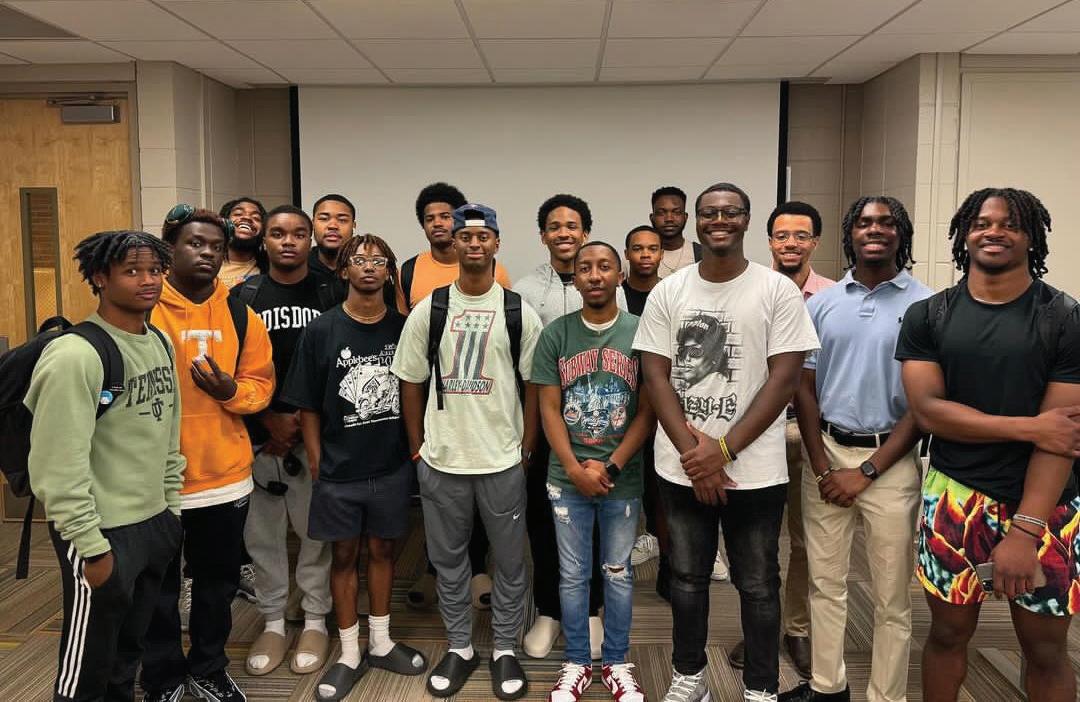
To these men, BUE is much bigger than just a group of men who need a professional headshot or some pointers on their resume. The most important thing to them is that it is a safe space. Regardless of academic, professional or personal development, what BUE prioritizes is being a place where brothers can come with their trials as well as their triumphs, knowing that support for both will be gladly given.
“My freshman year, I remember a question that we asked, and it was, ‘What does it mean to be a man?’’’ Campbell said. “With that question, that’s when I really felt at home. I saw the connections that a lot of us had no matter where we were from. From California to Memphis, there was still some kind of connection with our past and how we view ourselves now. After that is when it felt like a safe place for me, as a minority man.”
Once community is fostered, opportunity is soon to follow. One of the biggest things BUE preaches is a can-do attitude for all of its members no matter their career goals or personal plans. For Wesley Turner, BUE’s presidential liaison and a senior studying sports management, that idea is the crux of what makes their organization so special.
“I wanna make sure guys have a conscience of, ‘Why can’t I?’” Turner said. “Asking why can’t I win this award, get this
internship, live in this city for a summer, like why do we tell ourselves that? It’s because the world tells us that, but if the world is consistently telling you that, how are you supposed to shift? Getting guys to recognize that it’s completely on them, but you’re capable and have the opportunity. They don’t have to question whether or not they should be here now, but what are they going to do every single day to make sure they and their people are straight.”
Mental health, a topical point of discussion within identity and masculinity today, is also constantly preached as a cornerstone of any BUE brother’s success both in the corporate world and behind closed doors. If you’re emotionally intelligent, other aspects of knowledge and realization seem to fall into place. To them, it’s yet another stepping stone toward a successful future. Nicholas Moore, BUE’s director of academic excellence and a junior studying aerospace engineering, noted that men need to know how to deal with their emotions safely and healthily in order to be strong men.
“I don’t know if it’s just these days, or it’s been like this forever, it just feels like men are supposed to have control over their feelings,” Moore said. “But they don’t ever teach you to control those feelings. They just show you pushing it down, and that’s not con-
trol. That’s just prolonging the effects of it. So we’ll talk about those directly, like with our mental health series, or subtly with a, ‘How was your day?’ Or, ‘Are you good right now?’”
For a lot of minority groups, mental health is often an unnoticed or neglected aspect of existence that’s ignored due to a lack of resources. In many instances, those feelings are pushed aside to make room for the bigger picture, which is a notion the brothers of BUE are constantly trying to fight. For them, identity and masculinity are huge and often congruent topics of conversation. Being successful but losing yourself in the process is far from the end goal for BUE. When prosperity in academics and mindfulness collide, BUE thinks the sky is the limit.
There may be a high standard that these men hold themselves to, but by no means is that meant to intimidate or exclude any potential new member from growing their 92man roster. A lot of members will bring anywhere from one to 10 friends with them to a meeting, the itinerary of which can range from practicing interview skills to something as simple as a movie night with friends. For BUE and everyone involved, success is something to be found in almost every aspect of living. If their slogan says anything, success in relationships is a good place to start.
The weather in Knoxville is starting to warm up a little bit which means it feels nice to finally spend time outside in the sun again. Good weather pairs perfectly with eating a good meal outside like brunch. Brunch is a simple social activity to catch up with people and fill up on good comfort food. Below are eight brunch recommendations to enjoy in Knoxville.
Tupelo Honey
Tupelo Honey is located in Market Square. It has brunch options on Saturday and Sunday until 4 p.m. This place features several classic southern options, such as chicken and waffles, fried chicken benedict, and shrimp and grits. They also have lighter options like avocado toast and eggs. As for seating, there is an outdoor patio that is pet-friendly.
Ruby Sunshine
In contrast to Tupelo Honey, Ruby Sunshine has an all-day brunch menu but is also located in Market Square. Some of their specials include the bananas foster french toast, biscuits and gravy, and the trifecta, which calls for “Taste of Ruby featuring our signature Benedicts: Eggs Cochon,
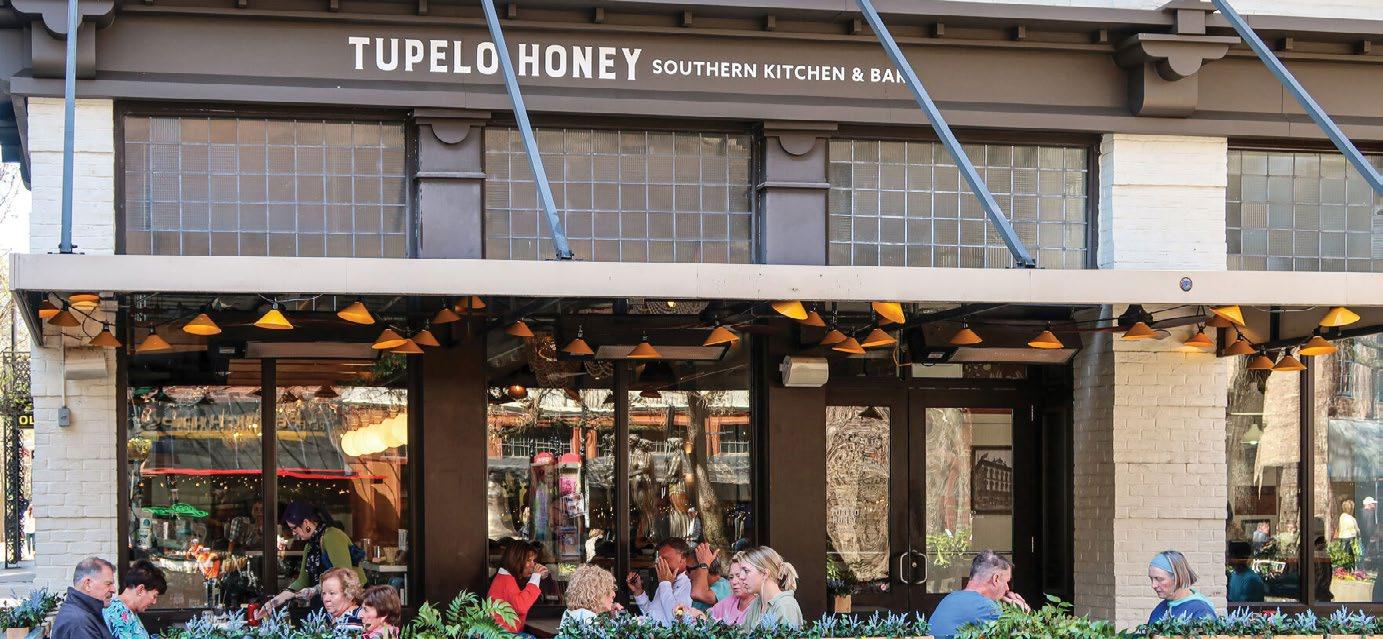
Tupelo Honey offers outdoor seating for guests to enjoy a view of Market Square. Monday, March 21, 2022. File / The Daily Beacon
Chicken St. Charles and Bayou Shrimp” from the menu. This restaurant brings New Orleans flavors to Knoxville. Along with the appetizing food, there are several alcoholic drinks to taste.
Café 4
This restaurant serves brunch on Saturday and Sunday from 9 a.m. to 3 p.m. Café 4 offers many options of brunch alcoholic beverages as well as a variety of coffees. The brunch includes traditional breakfast food as well as lunch options. Some lunch options include a grilled chicken sandwich and their café burger. They also have
punch bowls for a unique brunch option.
Oliver Royale
Also in Market Square, Oliver Royale serves brunch on Fridays, Saturdays and Sundays. A benefit of this restaurant is that it supports the Knoxville community by serving local food. The chefs and owners are huge advocates for organic and eco-friendly food practices. The restaurant itself has three levels of dining tables and has food options with everything from breakfast pastries to tacos.
Harvest
Harvest brings live music as well as satisfying food to their customers. The brunch menu is broken up between lunch, breakfast and brunch options to help customers decide what they want with the variety of options they have.
Frothy Monkey
Frothy Monkey gives more availability for brunch — they serve it all day, every day until 5 p.m. There are numerous types of pastries to try as well as nutritious salads and sandwiches. They also offer a selection of desserts like cookies and different cakes.
First Watch
First Watch is a chain restaurant known for its brunch options. Besides the brunch coffee and cocktails, they have a unique juice bar. The purple haze, kale tonic and the morning meditation juices give a refreshing taste for brunch.
The Tomato Head
For those who normally have food allergies or require vegan options, this is the place to dine at. This restaurant also takes pride in providing less processed food and nutritious options. They serve these healthy brunch options on Saturday and Sunday until 3 p.m. Some fun options are the build-your-own waffle and the breakfast bowls.
From Jan. 26 to April 14, Carmen Winant’s exhibit entitled “A Brand New End: Survival and Its Pictures” is on display at the Knoxville Museum of Art. This exhibit is meant to bring light to experiences that women have and how strength can shine through such bleak moments.
Winant, a photographer from Philadelphia, has worked on this exhibit for a few years and collaborated with Women-In-Transition and the National Coalition Against Domestic Violence.
Winant pulled photographs and newspaper articles from the two organizations’ archives to collage together a display of women’s violence that has not been shown to the public in years.
Winant uses over 500 newspaper clippings of articles on domestic violence that were put into inventory and puts them against colored copy paper to create a giant wall of different stories. Throughout the stories of terror and violence that have harmed women, the way they work together to become stronger is what takes center stage in the gallery.
Winant had previously done a project on feminist healthcare work and is working on another project for abortion clinic workers. This project felt more personal as Winant is from Philadelphia

and going through these stories of domestic violence hit home but also made her feel empowered to put on this work that transcends boundaries.
“(This exhibit) illustrates how we work together in community to support one another,”
Winant said. “How we build new worlds for each other in this oppressive system known as patriarchy.”
On another side of the wall are photographs of women working in a male-dominated space or rallying together to support each other. It shows
the joy and freedom of feminist spaces that shine brighter than any difficult moment prior. There is also one side of the wall that has books stacked up to be the size of a person. The books are all survival guides that these spaces have available.
Although there is a wooden table with plants in the center, it is the corners that draw attention. On bright cardstock paper are “Power Control Wheels” which are often handed out at domestic violence centers for those who are looking for signs of abuse in their own or another’s rela-
tionship. These are free for the audience to take home and create an interactive moment between the community and the artist.
The backroom of the exhibit is one of the most intricate parts of an exhibit one may see. Its projects are scattered throughout the room projecting different images on a wall. Each projector has a carousel of photos to go through. One reel shows images of shirts created for the Clothesline Project, which started in the ‘90s for survivors of sexual violence who wanted to express themselves creatively. These shirts were made by survivors or family members who lost someone through domestic violence and wanted to empower others through their art.
D Schmerber is working as an employee for the Knoxville Museum of Art and was able to share how this exhibit is unlike any that they have assisted with before. They said their position also comes with knowing the art and artist in case anyone has questions during an exhibit showing. However, this is their first feminist gallery that depicts domestic violence.
“I always love exhibits that challenge people’s ideas and comfort zones,” Schmerber said. “It’s a challenge because the back of my mind does not want to hear this, but the front of my mind needs to see it to learn more.”
Art has many forms, and Winant intends to tell stories and invoke deep meanings through the art of photography.

“Madam Web” released in theaters on Feb. 14, 2024. Courtesy of IMDb
Since Sony Pictures teamed up with Marvel Studios to bring Spider-Man into the Marvel Cinematic Universe, they’ve been on a mission to expand their own interconnected cinematic universe. Their latest venture, “Madam Web,” is another step in this ambitious journey.
Following in the footsteps of “Venom” and “Morbius,” “Madam Web” dives into the rich tapestry of characters associated with SpiderMan in Marvel Comics. However, the unique challenge for Sony lies in working around the absence of Peter Parker, dictated by their deal with Marvel Studios.
In “Madam Web,” this obstacle sparks creativity, introducing four other characters with connections to the Spider-Verse, albeit in a rather unconventional manner. It’s a bold move that adds layers to Sony’s expanding universe, offering fans a fresh take on familiar characters in the absence of the friendly neighborhood webslinger.
“Madam Web” follows the story of Cassandra “Cassie” Web, played by Dakota Johnson, who discovers her clairvoyant abilities after a life-threatening accident. As she grapples with her newfound powers, Cassie intersects with three young girls: Julia Cornwall (Sydney Sweeney), Anya Corazon (Isabela Merced) and Mattie Franklin (Celeste O’Connor). These girls become the target of Ezekiel Sims (Tahar Rahim), a man who gained powers from the very spiders Cassie’s mother researched. Convinced the three girls pose a threat to him, Ezekiel sets out to eliminate them first.
My main issue with “Madam Web” is the script, which was written by Matt Sazama, Burk Sharpless, Claire Parker and director S.J. Clarkson. In certain scenes of the film, not even the talent of its top actors can save lines that feel
forced and awkward. Johnson’s signature dry delivery sometimes turns Cassie’s clichéd remarks into unintentionally funny moments rather than heartfelt ones. For example, lines like “Hope the spiders were worth it, Mom” end up eliciting more chuckles than genuine emotion.
Rahim’s portrayal of Ezekiel is burdened with even more ridiculous lines than the stars of the film, reducing him to a stereotypical Marvel movie villain, rather than a fully acknowledged character. Similarly, the three Spider-Girls are mere sketches of their backstories, embodying archetypal teenage girl personas rather than fully developed characters.
Mattie serves as the rebellious one, Anya as the brainy counterpart and Julia as the awkward girl next door. Their roles seem limited, providing little beyond obstacles for Cassie to navigate. Even in attempts to foster a dynamic among them, the chemistry between them just isn’t there, though this isn’t necessarily their fault, as it seems unlikely that no amount of star power could pull off this terrible script.
As much as I wanted to go into seeing this film with an open mind after seeing countless negative reviews about the film, I’m afraid I must agree with most critics who say that “Madam Web” has little to no redeeming elements to it.
The storytelling is confusing and even frustrating at times. Cassie Web’s backstory makes no sense to the point where it is almost laughable. Even with Spider-People in the movie, “Madam Web” can’t make up for the glaring hole that is Spider-Man, despite the film constantly making references to the audience about him.
Overall, in my opinion, the film is not great, but there are some good parts. If you are a fan of the Marvel universe, this movie is one that you can skip without any second thought. If you are just a casual movie enjoyer and a fan of talented actresses such as Sweeney and Johnson, maybe give it a watch — but wait until you can do so on a streaming service rather than wasting money at the theaters.




There are a lot of elements of Southern — or even simply American — culture that most people take for granted probably without even realizing it. Sometimes it isn’t until that culture is tested or put on a pedestal that we realize the value in the simple hospitality we give to others.
For Yoshitoshi Momoki, a Japanese native who graduated from UT in 1993 with a broadcasting degree, those sentiments made themselves known during his first semester on Rocky Top. Thirty years later, it’s still a mindset he displays fervently.
“The first Christmas break after the fall semester, I didn’t have money to go back to Japan, so I had to stay,” Momoki said. “Then my friend tells me his girlfriend’s roommate wants to bring me to Nashville to spend Christmas. I didn’t know that it was such an important family gathering. They started exchanging gifts, and at first I felt so lonely, but then at the end there was a small gift for me. So after that, I learned about Southern hospitality and treating others as if they’re part of the family.”
Momoki’s appreciation of such a simple gesture has seemed to manifest itself in a number of ways in his life and personality. Most recently, it manifested into a brick-and-mortar establishment in Tokyo, Japan, in the form of the aptly named Good Ole Tennessee Bar. The bar is centered around the cultural significance of not only UT but the state of Tennessee as a whole. From Jack and Coke’s to a neon “Welcome Y’all” sign at the front door, everything about this place screams simple Southern charm.
Good Ole Tennessee Bar has been open for nearly two weeks now, with its first day having doors fully open being Feb. 14, 2024. While still pretty fresh, it’s been a dream of Momoki’s for years now. After spending many sleepless nights wondering what his next steps would be, Momoki finally landed on a reason for his restlessness: a want to bring his good ole days home with him.
By 2019, he says it was clear that those memories would manifest themselves in the form of good times and good whiskey. While nostalgia may have been the original fuel for what’s become of that dream today, Momoki is also determined to show off the love of his second home in the hopes of spreading its sentiments.
“The idea came to me, to share my fond memories of UT and Knoxville,” Momoki said. “There’s so many things unknown about Tennessee to Japanese people. The economic ties, lots of Japanese companies have branches in Tennessee, but many people don’t know about it. I want to change the status quo by having a place like this.”
That desire to educate is noticed as soon as one walks through the door, and Momoki prides himself on the decor and interior design be-

ing wholly unique to the Tennessee experience. There’s Tennessee whiskey, a chili-cheese dog akin to a Neyland Stadium concession and on the loudspeakers you can even hear classic country music being played on Knoxville’s historic FM station, 107.7 WIVK. Homework is clearly not something lost to Momoki, even after his days in the classroom are far behind him.
For most natives that come across Momoki’s establishment, he says the first thing out of their mouths is usually, “Where’s Tennessee?” It’s a question that he’s more than happy to provide an answer to, as one wall provides a map of the state itself with other region-specific memorabilia being used as decor all around the place.
There are pictures of Elvis and Tina Turner, Vols and Titans football helmets and even a replica of the iconic “I Will Give My All for Tennessee Today” sign that hangs above the locker room in Neyland Stadium can be seen at the front door. Momoki cites Disneyland as his atmosphere inspiration, saying he wants to capture the magic to a point where an evening spent at his bar feels just like one back in the Volunteer State.
Jorge Varona is a patron of Good Ole Tennessee Bar who also had Momoki as a tour guide through Tokyo.
“Despite how crazy the world is, there are
people that are genuinely good-hearted, curious and friendly,” Varona said. “This is not exclusive to the South but generally portrayed that way in contemporary media. Yoshi is a good human, and we will stop by on our next visit later this year. Our return, in part, has to do with several of our experiences with Yoshi.”
For natives of Japan, Momoki is as good of a tour guide as anyone to introduce Tennessean culture. As previously stated, not a lot is known about the state to most Japanese people, and often exposure to it is met with suspicion or even trepidation. Whatever intuitions or preconceived notions they may have, Momoki makes sure that home is as real of a feeling as it is a place on a map.
“The feeling is quite suspicious, in a sense,” Momoki said. “Expectations are very low, sorry to say, but the thing I offer is quite high. I’ve been designing for five years, so the details really do represent Tennessee, and they end up loving it. I think I’m a good ambassador for Tennessee.”
Currently, Momoki is the sole employee of Good Ole Tennessee Bar, with all bartending and food service responsibilities resting on his shoulders. He orders all of the domestic beers and imported liquors, which range in origin
from Tennessee to Ireland, as well as cooking homemade, authentic American chili himself. As hectic as wearing so many hats can get, Momoki never seems to have the passion for his dream wavered. To any Tennessee fan, that grind-until-the-clock-stops attitude is one that’s all too familiar.
“I watched the Tennessee versus Alabama game last year on YouTube streaming,” Momoki said. “And I cried. Especially because we hadn’t beat them in 15 years, and on the kick in the last two seconds. That game meant a lot to me. Since 2019, I’d wanted to open this bar, and nothing really got on the right track. That game told me ‘Yoshi, you should not give up. Until the last second, keep going.’”
It’s comforting to know that no matter where you are in the world, someone clad in orange who knows all the words to “Rocky Top” is likely just around the corner. Momoki says he’s already had more Tennessee alumni and other residents of the state reach out with intentions of visiting, as well as bringing their own mementos of home to fill his new bar with.
However far Momoki may be from that first Christmas break in college, the sense of gratitude and generosity he saw then seems like it has failed to evade him ever since.

When thinking about reading as an activity, many people tend to picture a quiet, cozy room in which they sit alone with a book. This picture of solitude is probably why readers are often compared to hermits, but that isn’t exactly the case.
Alone time with a good book is certainly a luxury, but I think it is a missed opportunity when one limits their reading to a solitary space, physically or mentally. In many ways, reading alongside someone can actually enhance your reading experience.
Outside of the pages, there is a massive community centered around reading. It reaches from your local library all the way to your For You page on TikTok.
Today’s advanced technology definitely comes in handy for book-ish types. One search on almost any platform can lead you to your fellow readers. There are even fandoms, or groups of fans, for specific books, authors or series.
However, this whole book community thing isn’t anywhere near new. I’m certainly not the first to suggest that readers branch out. I mean, we’ve all heard of book clubs, right?
I joined my first book club in elementary school, too long ago to remember the exact grade. Before school started, we would gather into a circle that accommodated our small size and talk about whatever books we had last read. There wasn’t really much intellectual conversation going on, but we had fun sharing with each other. We would get a donut and pick out a new book at the end.
If I’m being honest, most of us were there for the donut part.
Regardless, those 20-to-30-minute meetings changed the way I thought about what I read. There’s something special about sitting around with fellow book lovers and discussing your most and least favorite chapters, even though my teacher bribed us with sugary treats to get us all there at once.
As I got older, I looked back on that elementary school book club and thought that it was silly and childish. I didn’t realize that it had inspired the deep discussions that my best friend and I had about our latest fantasy reads, nor did I recognize its ghost within my overupdated and over-detailed Goodreads
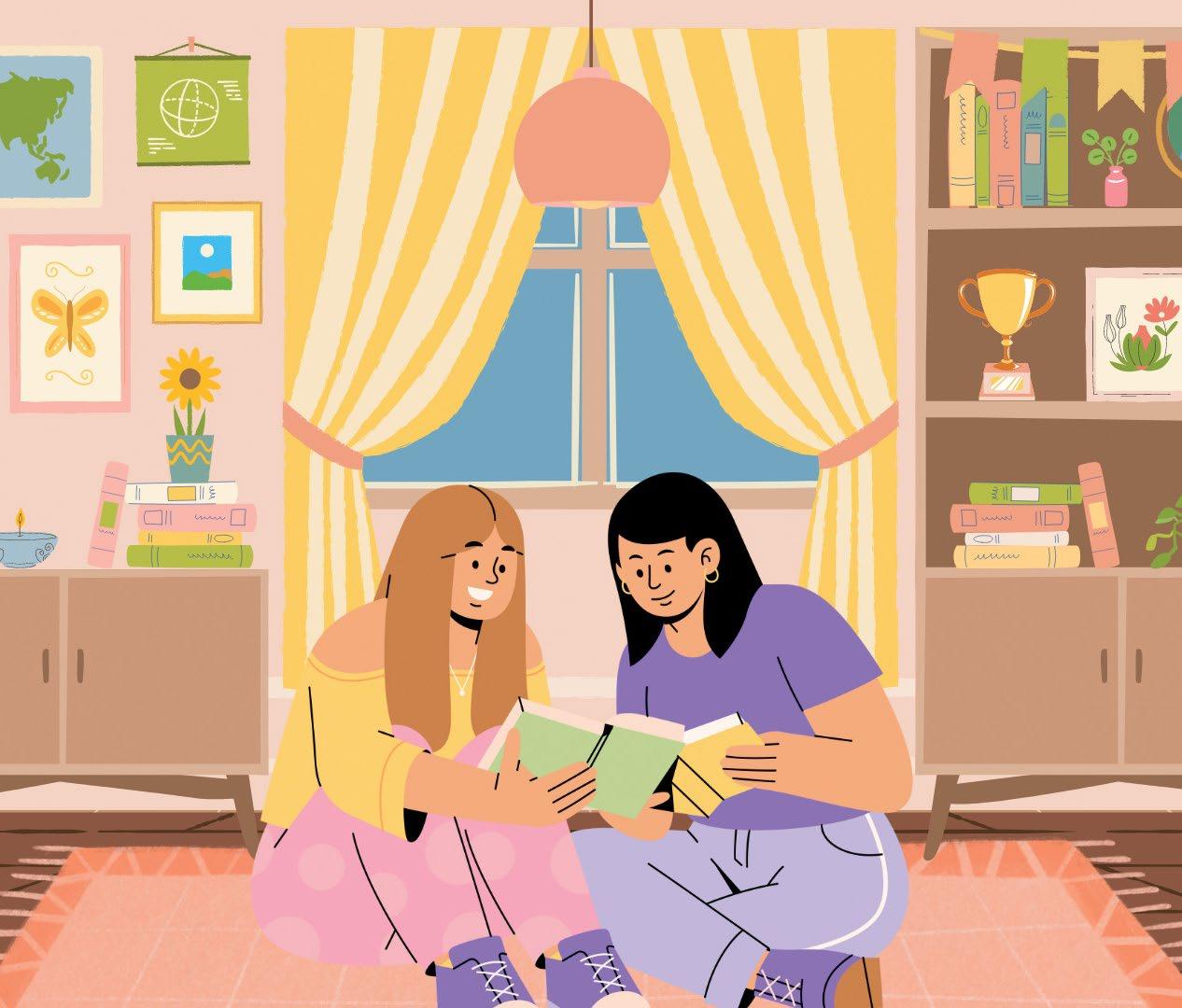
account.
Once you experience a book community, it’s almost addicting. I long to discuss the lines or scenes that cut me deep or the characters I connected with on a level I didn’t realize was possible. This drive for conversation often comes in handy at times you wouldn’t expect, like when trying to make new friends. Just find a favorite book you have in common, and the discussion begins. As a result, a sort of connection forms as well.
I’m someone who identifies as the opposite of outgoing, so this is a favorite tactic of mine. Books not only act as a helping hand when making new friends, but they can also deepen pre-existing friendships.
For example, one of my favorite memories is a three-hour reading binge that
my friend and I took on in the middle of a cafe. We eventually had to leave because the cafe was closing, but sitting on that couch with a coffee and pastry had set up the perfect reading conditions for us. We read and shared our every thought, often getting off on tangents whenever one topic led to another.
I like to think about that day, not because I had such a good time with my book, but because it reminds me of that friend. Honestly, I am only vaguely aware of what I had been reading that day. What was really important about those three hours was how much we bonded just by cracking open a book.
Just recently I convinced my roommate to read one of my favorite series. Now, we have reading breaks dotted with literary references that she wouldn’t have understood only a few weeks ago.
Reading with other people is almost like sharing a language. No one can understand how you feel about a book like someone who has had the same experience.
That said, I hope all readers get the opportunity to share their own book-ish language. Be warned, though. It’s hard to stop once you’ve started!
Heading into the first week of March, Tennessee men’s and women’s basketball are in very different positions.
For the men’s team, a status near the top of the pack in March is all but solidified. The Vols are fresh off a dominant win against Texas A&M at home with several ranked tests awaiting.
As for the women’s team, the seeding is very much in flux with not much season left. A loss against ranked LSU on Sunday didn’t help the case either. The Lady Vols have a home matchup with Texas A&M on Thursday before wrapping up the season against No. 1 South Carolina in Columbia.
Here’s a look at where the Vols and Lady Vols stand in current March Madness projections.
No. 4 Tennessee basketball (21-6, 11-3 SEC) has a gauntlet of a week ahead.
The Vols host No. 11 Auburn on Wednesday night before traveling to No. 14 Alabama on Saturday. The week could be a big chance for the Vols to solidify their place among the top seeds in March Madness.
Tennessee’s resume is strong as it is. The Vols have been on the line between a No. 1 seed and No. 2 seed in several projections. Standout wins in Rupp Arena of Kentucky and in December at Wisconsin highlight the resume.
Tennessee has also picked up wins against Alabama and Illinois at home, helping bolster its resume.
Tennessee does have five Quad 1 losses, but three of the teams are projected to be top seeds in March. A Quad 2 loss to South Carolina is likely the worst on the Vols’ resume.
Currently, ESPN’s Joe Lunardi projects Tennessee will end up as a No. 2 seed in the South Regional — running through Dallas. The Vols would open with No. 15 seed Fairfield in Charlotte before facing the winner of No. 7 Colorado State and No. 10 Wake Forest. The No. 1 seed in Tennessee’s region would be Houston.
A positive for the Vols is they avoid a trip to Los Angeles as part of the West Region, and a matchup with Houston for a trip to the Final Four would be favorable. The Cougars are a defensive-heavy team with their offense failing them in losses.
In Jerry Palm’s projection on CBS, the Vols would slot in as a No. 2 seed in the Midwest Region. The first-round matchup would be against No. 15 Morehead State in Memphis before facing the winner of No. 7 TCU and No. 10 Colorado.
Purdue would be the No. 1 seed in this projection, a team that defeated the Vols earlier in the year. The region would go through Detroit,

also avoiding a trip to Los Angeles.
Lady Vols basketball head coach Kellie Harper feels strongly about her team’s status in the tournament.
At 16-10 (9-5 SEC), the Lady Vols consider themselves to be firmly in the tournament picture based on a variety of factors.
“To me, if you watch the games, we pass the eye test,” Harper said. “We played really well at times, and I think that has to be a part of what the folks are looking at, so I feel really good about our team and going into postseason.”
ESPN bracketologist Charlie Creme agrees with this opinion. He sees the Lady Vols as a No. 9 seed in his most recent projection on Tuesday. The seeding is the highest given to the team by Creme since conference play began.
Creme believes the Lady Vols will head to Columbus, Ohio, for the first weekend of the tournament, with the first round coming against No. 8 seed Florida State. Tennessee went to Tallahassee, Florida, to take on the Seminoles, losing 92-91. Rickea Jackson scored 31 points and earned 17 rebounds in the loss.
The Lady Vols also previously faced the Buckeyes this season, losing to the projected No. 2 overall seed in Knoxville. Jackson was unavailable for Tennessee in the game, and the
Lady Vols lost 78-58 to the Buckeyes. Mark Schindler of The Athletic also released a bracket on Tuesday, and he sees the Lady Vols as a No. 8 seed. They would head to Los Angeles to take on No. 9 seed UNLV in the first round. With a 24-2 (14-1 Mountain West) record, the Lady Rebels have been one of the best mid-majors in college basketball and are one of two mid-majors to be ranked in this week’s AP poll.
A win over UNLV would see the Lady Vols take on projected No. 1 seed USC. The Trojans are led by freshman JuJu Watkins, who averages 28.2 points per game. USC would be a tough second-round opponent for the Lady Vols if they met in the second round.
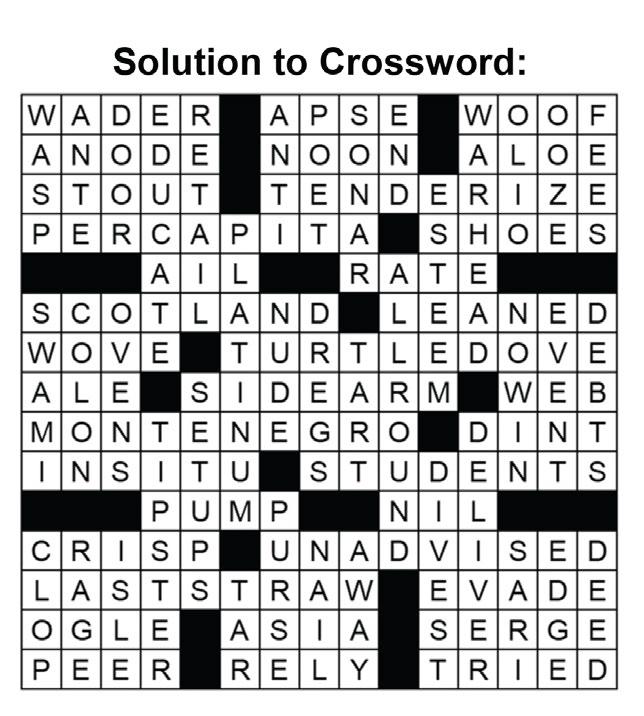
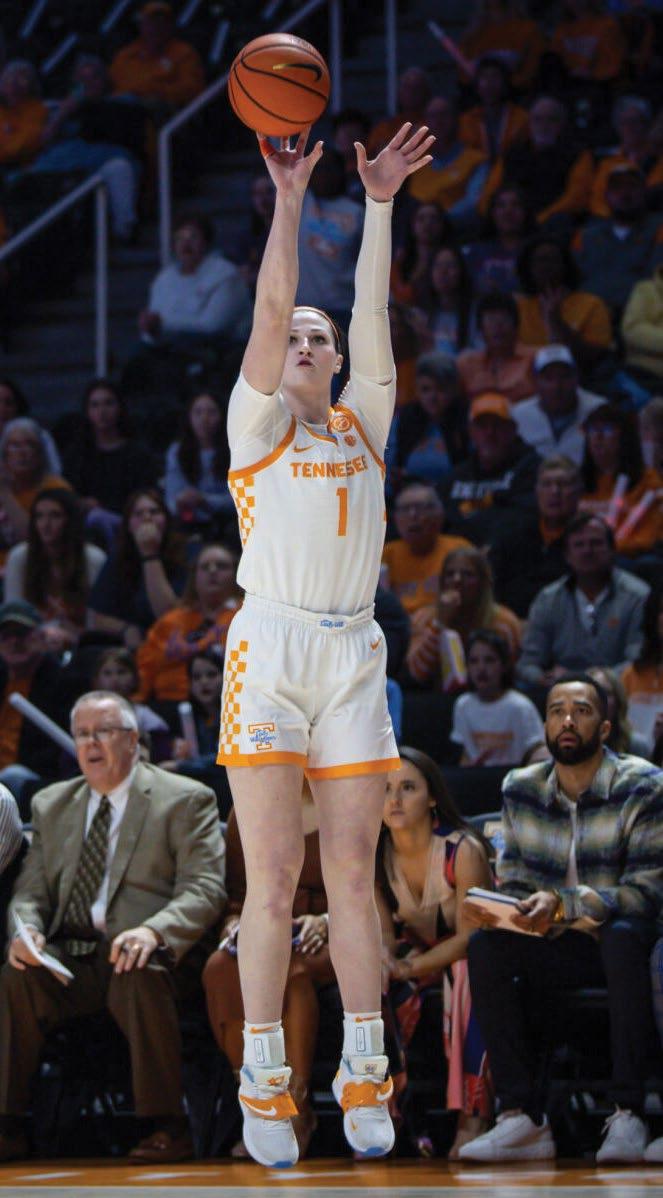
Jonathan Skrmetti was just 5 years old, but the moment left a lasting impression on him.
Standing in line at Disney World, a man cut in front of Skrmetti and his dad. The man was much larger than Skrmetti’s dad, but that didn’t stop him from speaking up. He told the man to go to the back of the line.
Rules are rules no matter who you are
It’s a message that Skrmetti has held with him. He took it with him while he earned undergraduate degrees from Oxford and George Washington before attending Harvard Law School. Now, he is taking that fearless mantra to the Tennessee Attorney General’s Office.
The job hasn’t been without fights since Skrmetti took the oath on Sept. 1, 2022. He has brought up suits against companies like Ticketmaster. More recently, he has targeted the NCAA.
Skrmetti and the state of Tennessee earned a “win” in their antitrust suit against the NCAA with a federal court granting a preliminary injunction regarding the suit. It is another case in which Skrmetti has found success against the NCAA after getting a preliminary injunction regarding multi-transfer rules in December.
The 47-year-old Skrmetti isn’t scared to take on big corporations or governing bodies. In fact, he welcomes it.
“If people can get away with things just because they’re bigger and more powerful, that’s not the world we want to live in,” Skrmetti said. “But it only works if people stand up. At (the Department of Justice), I sat across the table from murderers, child sex traffickers, neo-Nazi organization leaders. You just get used to talking to people who are ordinarily intimidating. And if you do it enough, they’re not. And with the big corporations, it’s the same deal.”
State of Tennessee commands respect
Former Tennessee Attorney General Herbert H. Slatery III remembers standing on the fairway golf course in Iowa. Completing his eight-year term as Tennessee attorney general in 2022, he kept hearing Skrmetti’s voice. It was a voice he easily recognized — Skrmetti served under Slatery as chief deputy attorney general.
Skrmetti wasn’t on the golf trip, but he was being talked about. On the adjacent fairway, several other chief deputies and other assistant attorneys general watched as Skrmetti talked to the Tennessee Supreme Court about why he should take over as attorney general.
“I just thought that’s so cool that they were that interested in knowing how he’s doing,” Slatery said. “Because that’s not something that — No. 1, you’re not supposed to be lis-
tening to something on a golf course where everybody could hear it anyway, but they were listening to see how he was doing, and a bunch of them were pulling for him.”
Becoming attorney general in Tennessee is unique. The position is not an elected position, but it is instead appointed by the Tennessee Supreme Court.
The unique process allows attorneys general, like Skrmetti, to not worry about politics or earning votes. The office is free to pursue cases that are important to the attorney general. Some of those cases prove to be partisan, and he has received political backlash for his role in cases revolving around hot-button topics. For example, Skrmetti’s office received blowback for receiving medical records from Vanderbilt Medical Center regarding transgender patient medical records.
In most cases, though, Skrmetti works on bipartisan issues and collaborates with states regardless of political leaning.
It also earns the state of Tennessee extra trust when it enters the room.
“I have a pretty clear runway to just try to do the best I can and do right by the people of Tennessee,” Skrmetti said. “I think that’s a big advantage to the state. I think there are a couple different reasons that having the appointment process the way we have it is really good for Tennessee.
“You get somebody who’s typically nice and typically a good lawyer, and that makes for a great office culture because no matter who the AG is, they tend to fit a particular mold that attracts people who love public service and want to stick around and stay here for a long time.”
Not having to play politics earns the state of Tennessee a leadership role in many suits while encouraging bipartisan efforts.
Not having to run for office does draw some light-hearted criticism from colleagues, but it comes with a sense of instant credibility.
“I was introduced a couple of times, and your colleagues can make fun of you and that sort of thing,” Slatery said. “They may make fun of you about not being elected and that sort of thing.
“But I had several of them say, ‘We’ve known and known for a long time when Tennessee walks in the room, there’s a real lawyer in the room.’ And General Skrmetti is no exception to that. They recognized that real fast, even when he was chief deputy.”
January’s leak of the NCAA investigation into the University of Tennessee wasn’t the first time that Skrmetti has paid attention to the NCAA.
The attorney general wrote a letter to the NCAA during the investigation into Jeremy Pruitt’s recruiting violations, arguing that a bowl ban should be out of the question given

UT Chancellor Donde Plowman cleaned house with a clear motive of legal action if the punishment was too severe.
Even when Skrmetti was chief deputy, then-Attorney General Slatery considered bringing forth a suit against the NCAA. The governing body was investigating one of the state’s institutions and behaving poorly in doing so — an investigation neither Skrmetti nor Slatery could pinpoint due to attorneyclient privilege.
“Everybody was twisting themselves in knots trying to do what was right, trying to respond to the investigation appropriately and they were not being treated well,” Skrmetti said. “And there was just a sense of impunity where the NCAA enforcers, even though they had ostensibly adopted new processes that would make it fairer, were just doing whatever they wanted. And I think that comes from the concentration of power that the organization has. That was on my radar when I took over as the attorney general.”
Pursuing antitrust suits without fear is one half, but finding success is the other. Skrmetti has generally been successful since joining the attorney general’s office.
That comes at no surprise to Slatery, who brought Skrmetti to Nashville. The Harvardeducated lawyer boasted a background in criminal law and was teaching cyber-related courses at the University of Memphis when he was cold-called about becoming chief
deputy.
The plan was for Skrmetti and his family to live in Memphis, his wife’s hometown, forever. Instead, he accepted the job and began commuting back and forth from Germantown to Nashville every week.
Six months later, his family moved to Franklin to plant new roots.
“He made a sacrifice to serve the state,” Slatery said. “He worked really hard. We’ve worked very, very closely together on the opioids litigation and in a number of constitutional issues. … He just did a great job for us. I have great respect for him.”
Skrmetti quickly earned respect in Nashville, serving as chief deputy attorney general from 2018-21. He applied to fill a Tennessee Supreme Court vacancy in 2021,but did not get the position. He then served as chief counsel to Tennessee Gov. Bill Lee until August 2022, when he began the process of earning his current post.
It was a quick transition from private practice and teaching to serving the state of Tennessee. It is also one that has thrust him into the public eye for suits against the NCAA and a host of other work he has done.
With the first win against the NCAA on Friday, it is full steam ahead for Skrmetti and his office in their quest to protect Tennesseans.
“No matter who’s on the other side of the table,” Skrmetti said, “if their client did something wrong, they need to be held accountable.”
